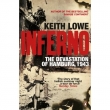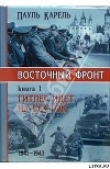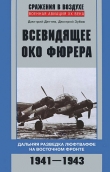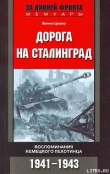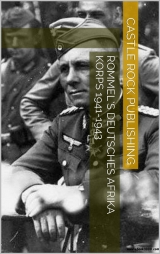
Текст книги "Rommel's Deutsches Afrika Korps 1941-1943"
Автор книги: Автор Неизвестен
Жанры:
История
,сообщить о нарушении
Текущая страница: 12 (всего у книги 19 страниц)
By this time the desert army of Erwin Rommel and the panzer army of von Arnim had combined in a prickly partnership with each leader having different ideas of how to conduct operations. British pressure by 8th Army on the southern Tunisian front led to the evacuation of successive defensive positions and illustrating these actions is the account of the fighting by 164th Infantry Division in the Schott and the Enfindaville lines.
The final phase of the war in Africa is covered in a description of the engagements in which 999th (Africa) Division took part on the western front of Tunisia. This division was made up of men convicted for military crimes: desertion, insubordination, striking a superior, and neglect of duty. Only through battle could these men win back their military honour and, although their unit never reached full strength but was made up of individual battle groups, the men served loyally and bravely winning back not only their own self-respect but more important still the respect of their military comrades.
To the desert veterans of both sides the war in Tunisia was completely different to that which they had fought in Egypt and Cyrenaica. The rocky mountains of Tunisia limited the horizons of the men who had come up out of Egypt. For the men of the old Africa Corps there would be no longer the exhilarating hundred-mile advances; no more the battlefield restricted to a 50-mile wide strip of desert south of the Via Balbia; no more the goals of Alexandria and the Suez canal to spur them on. Instead there were the eternal bare hills or djebels, the ever-vigilant OPs, and an awareness to every soldier of the Axis armies that with defeat Tunis would become the first of a series of stepping stones leading on to Sicily, from thence to the mainland of Italy and. finally, to Germany and to the defeat of the German—Italian Axis.
On 8 November, the day of the Allied landings, an ad hoc collection of remnants from Ramcke's Para Brigade was formed into Battle Group Sauer and flown to Tunisia to secure the airfields at La Marsa and at El Aouina. Fighter aircraft of 53rd Geschwader touched down on 9 November and these first 27 machines were followed by 24 JU 87 Stuka dive-bombers. On successive days JU 52 and ME 323 machines came in bringing supplies, light anti-aircraft guns, and the two battalions of Koch's 5th Para Regiment. These landings met with no resistance from the French for diplomatic negotiations had ensured that the Germans would not be met as enemies.
Colonel Harlinghausen of the Luftwaffe was given overall command of the Tunis lodgement area and Colonel Lederer assumed the same powers in the perimeter around Bizerta. Once these bridgeheads had been consolidated then began the build-up of the forces and, to effect this, all available means of sea and air transport were switched from supplying Rommel's army to the reinforcement of the Tunisian front. So efficient was this organisation that by 12 November, two Italian ships had docked at Bizerta and within three weeks nearly 2000 men, 160 armoured vehicles, 127 pieces of artillery, and over 1000 soft-skinned vehicles, in addition to other military supplies, had been brought in by sea alone. Germany was fortunate in having a pool of transport aircraft and these were used to air-land reinforcements at a rate of nearly 1000 each day. By the end of November more than 15,000 troops had been air-lifted into the two perimeters.
As these new troops arrived they were fitted into gaps in the bridgehead, irrespective of regimental or national allegiance. Two infantry battalions from the Italian Superga Division were among the first to arrive and came under command of Battle Group Sauer. By such draconian methods, and as early as 14 November, the sector Tunis South had been secured. With a firm base line the German commanders could fling out battle groups westwards to gain ground and to seize important tactical positions. Koch's paratroops moved out in an advance to contact and hoped that this would not take place until they had established bridgeheads across the Medjerda river at Jedeida, Tebourba, and Medjez el Bab. Between the Allies and the Axis there was to be a race to see who could bring the stronger force to the decisive point in the fastest time and, although the Axis powers had reacted quickly, the western Allies had not been inactive nor unimaginative. [20]

A British paratroop attack had captured Souk el Arba and the British force went on towards the important road centre of Beja. A British sea-borne landing had captured the ports of Bougie and Bone and had brought two brigades of the British 78th Division to within 140 miles of Bizerta. The next obvious objective for both sides was the town of Medjez el Bab, the gateway to Tunis. In the several sectors at which they were disposed during the night of 16 November the Axis and the Allied soldiers prepared themselves for battle. With the next day possibly, within the next two days certainly, contact would be made with the enemy and the battle for Tunisia would begin.
General Nehring's return to Africa on 14 November was dramatic in that his aircraft crashed on landing and was totally wrecked. Determined not to let this accident upset his plans he called conferences in Tunis and Bizerta and. before returning to Rome to make his own assessment of the situation to Kesselring, he ordered that the troops in the Bizerta area be pushed westwards from Mateur to Tabarka to frustrate the British drive from Bone.
Nehring's opinion of the general situation was that the Allies had landed between 5 to 6 divisions in the initial assault and that this number had increased by a regular flow of reinforcements to a strength of between 9 and 13 divisions. On the German side there was no complete formation, excepting only the two paratroop battalions. There were so few troops that there was no real continuous line but a chain of qutposts defending the two main towns of Tunis and Bizerta. Behind this outpost chain there were two strategic areas -Mateur and Tebourba – around which there was grouped a small reserve whose task it would be, should the Allies break through, to delay their advance and to protect the disembarkation of the Axis reinforcements. The only real mobile reserve available to Nehring was a panzer company in Tunis and in Bizerta and these belonged to a panzer battalion which had been on its way to reinforce Rommel.
With such forces General Nehring realised that he could never halt but only delay any strong Allied assault and indeed, if we may anticipate the course of events, we shall see that the Allied thrusts which began on 21 November caused such alarm that the Germans were preparing to burn their secret files. It seemed to the German commanders at that time that their forces would be in occupation of Tunisia for only a few days and that the length of their stay would depend upon the speed and power of the Allied advance and the defensive ability of the Axis forces. But Nehring was too old a soldier not to realise that even with massive reinforcement a German victory was no longer possible and that the most his troops could do was to delay the inevitable Allied victory.
The problems facing Nehring were daunting in the extreme. He had no staff of officers to help him run his embryo Corps and he asked for the senior staff of 10th Panzer Division to be sent to Tunis to command the splinter groups which he nominally led and to establish a military system. There was neither radio nor signals equipment for HQ Nehring, as his command was called, and no transport. Strategically the situation was even more desperate. Nehring saw that the Allies' successful landings had given them the military initiative and that he must prepare for Eisenhower's forces to make the next move. This could be either a direct thrust for the principal objectives of Tunis and Bizerta thereby strangling the supply line to Rommel. Alternatively, part of the Allied armies could strike for the Gabes Gap, and thus contain Rommel while the main striking force of the Allied army attacked Sicily. Alternatively, the main thrust could drive from Gabes to the sea and thus separate the forces in Tunisia from those in Tripolitania while a smaller force contained the Axis armies in northern Tunisia. Thereafter, the 8th Army in the desert and the Allied armies in Tunisia could destroy the Italian-German armies piecemeal.
Nehring saw that his only counter lay in converting Tunisia into a strong area into which Rommel could withdraw his African army. This then, linked with the forces which he had been promised would arrive from Europe, would enable him to convert Tunisia into a wound in the Allied side. By switching his forces he could counter any assault in the north or south by threatening the flank of the attackers. But even more important was the supply route to Rommel's army and, with the expected loss of the port of Tripolitania, only the Tunisian harbours remained open and they were the nearest to Sicily and to Italy. But the political situation had to be regularised. Permission to enter and to transit through Tunisia was not sufficient; militarily he must occupy the country. For his part Kesselring aided the movement and on 16 November, in the interests of military administration, formed out of HQ Nehring the XC Corps with Nehring as General Officer Commanding and having power over German and Italian military forces in the Tunisian area.
Although the naval and air forces of Germany and Italy were not under Nehring's control the paratroop battalions – technically on Luftwaffe establishment – and two battalions of Italian San Marco Marines were assigned to him. The composition of the small force which had been dignified with the title of XC Corps was part of 5th Para Regiment, the Barenthin Para Regiment, of which at that time only Witzig's Para-Engineer Battalion was available, a battery of four 8.8cm flak guns, a reconnaissance squadron of six-wheeled armoured vehicles each armed with a 7.5cm cannon, and an infantry replacement battalion. The Italian component, in addition to the two battalions of marines already mentioned, was two battalions of infantry from Superga Division which had been rushed across from the mainland of Europe. Everything else was formed on an ad hoc basis. In the absence of signals equipment the Axis forces were forced to rely upon the French Post Office to maintain communication with their forward units. Until military vehicles arrived from Europe civilian lorries had to be hired to maintain the supply system and there was no military medical organisation; for the first months the sick and lightly wounded were treated in civilian hospitals. Even Nehring's driver was not German but a captain of Italian extraction serving on the French Army reserve. With this insufficient and un-coordinated force Nehring's orders were to strike for the Algerian-Tunisian border and to establish good defensive positions on the western side of the hills there. At all costs the Allies must be prevented from gaining observation points from which they could dominate eastern Tunisia. High ground was to be the key to success in the forthcoming battles.
The attitude of the French in Tunisia was dichotomatic. The senior officers of the services were either wholly or partially loyal to the Vichy French Government of Marshal Petain which had concluded an armistice with the Axis in 1940. Many of these officers and their civilian counterparts were prepared to tolerate and, in some cases, support actively an Axis occupation of the French North African territories. Other officers, particularly in the lower echelons of the military hierarchy, were pro-Allied and hoped to prevent an Axis occupation by delaying the Germans and the Italians and by allowing unhindered passage to the Allied armies.
Certainly the troops of Koch's paratroop spearhead had found the delaying tactics of the French quite exasperating. It was important for the German commander to know the French intention; whether General Barre was intending to remain neutral and passive or whether he was determined to go over to the Allies and deny to the Germans access to the bridgeheads across the Medjerda river. The area which his division was holding was of strategic importance and delay in clarifying the situation was of benefit to the Allies and a disadvantage to the Germans. French senior military officers deferred conversations between the paratroop officer delegation and the commanding general until leading elements of British troops, men of 6th Battalion the Queen's Own Royal West Kent Regiment, had entered and occupied Beja. The British 78th Infantry Division at that time comprised almost the whole of the Allied fighting strength in northern Tunisia and one of its Brigades, the 36th, was advancing as a left-hand column upon Bizerta, spreading a thin film of troops across the countryside.
The head of the column, the striking point, was aiming at Djebel Abiod and the important road junctions, in that place, of the Bone—Beja, and Bone– Bizerta highways. A second brigade of 78th Division, the llth Infantry Brigade, was advancing along the Beja road towards Medjez el Bab with the ultimate intention of thrusting towards Tunis. Supporting the two British infantry brigades was an Anglo-American motorised and armoured unit called Blade Force. The Allied fist with two ringers thrusting towards the enemy's vitals was preparing to strike.
The first major clash between the British and the Germans in Tunisia happened during the early afternoon of 17 November, when Major Witzig's battle group advanced upon Abiod from Mateur, aiming to reach Tabarka. His column was made up of two paratroop companies from the Para-Engineer Regiment's 11th Battalion, a squadron of 15 Panzer IVs, two Italian SP guns, a troop of 2cm flak guns, and a battery of 10.5cm cannon.
At Abiod three rifle companies of the West Kents, supported by a troop of 25-pounder guns and elements from 5th Battalion The Northamptonshire Regiment, were in position and dug in around the houses on the eastern side of the small town. The British infantry held fire even as the vehicles of the German battle group rolled past the houses and not until the 25-pounders opened up at almost point-blank range did the battle open. With the first shots some of Witzig's tanks were destroyed and the column was brought to a halt. The lorry-borne paratroops debussed and formed a firing line in front of the town while others raced for high ground and the artillery began a bombardment of the British positions. Under this barrage the soft-skinned vehicles were withdrawn. Witzig flung out a small infantry group to probe the British defences while the 2cm flak gun, which had halted and taken up position on the road, opened fire and poured a barrage into and upon the West Kent positions until a direct hit from a 25-pounder shell smashed the weapon and killed the crew.
Towards evening the firing died away and both sides took stock of the situation. Witzig had lost eight of his tanks and had failed to take the road junction but his infantry was on the important high ground and he was, therefore, in a superior tactical position. He could feel content; his small force may not have reached its given objectives but it had halted the eastward advance of a British column. A reshuffle of German forces during that evening brought the Witzig Group under the command of the newly formed von Broich Division. To build up the striking power of this division all Witzig's heavy weapons were withdrawn from him and handed over to Broich.
For the next two days barrage and counter-barrage succeeded each other in the Abiod sector while both sides sent out patrols to probe for weaknesses in the enemy's front. One German fighting patrol made up of No 1 Company of the Para Engineer Battalion set out on the night of 21/22 November just after midnight and had, by 03.00hrs, reached the road outside and to the north of Abiod. A challenge rang out from the British sentries, the para-engineers rushed the houses firing their machine pistols and hefting explosive charges into the buildings destroying British opposition. They returned to their own lines with minimal casualties.
The Luftwaffe was much in evidence during this period bombing and strafing the forward British positions and thereby aiding the efforts of the German ground forces. During the latter half of November Witzig's battle group, shrunken in number by casualties, received an Italian paratroop battalion as reinforcement. This crack unit was immediately committed to battle and launched an attack upon the 36th Brigade positions around Abiod. The assault collapsed in the fire of the British infantry and was beaten into the ground. Shattered by its losses the Italian unit was withdrawn and Witzig's men took over their former positions.
Vehicles of the only German armoured car reconnaissance unit in Tunisia were caught and destroyed in an ambush set by a British paratroop company in the area of Sidi Nsir during 18 November. Both sides were testing each other. This process continued on 20 November, when part of British 11th Brigade thrust a column along the valley of the Djournina towards Mateur with the intention of outflanking Witzig's group. The German commander relying upon the support of some Italian SP artillery switched the guns from flank to flank – at Abiod halting an infantry drive at Sidi Nsir stopping the advance of part of a British paratroop battalion. During this period a British armoured force was assembled to drive back the Axis forces from their positions on the Djebel Abiod and under this armoured pressure Witzig's met made a methodical, step-by-step withdrawal until they reached prepared defensive positions at Jefna.
Allied pressure during 18 November served to convince the Germans thai the time of crisis was at hand and that an all-out Allied offensive could be wholly expected. This anticipated advance, as the Germans saw it, would be facilitated by the attitude of the French vis-a-vis the Allies, for the Anglo-Saxons would be allowed to move with best speed towards the German bridgeheads. Nehring at that time had only four 8.8cm guns in Tunisia and he personally selected the sites on which they were placed. One was on the Pom du Fahs road and two others were set up to act as the last artillery defence for the capital. But, as the hours passed without the decisive thrust being made, Nehring grew more confident and flung out more and more battle groups to seize and to hold key points and vital heights. There could be no question of forming a battle line, just pockets of battle hardened men utilising even minute and every feature and turning both to thek advantage. As new units were formed or arrived in the akports they were rushed to the front and injected piecemeal into any sector where the need was greatest.

Kesselring, meanwhile, had promised that with 10th Panzer, the Hermanc Goering and the 334th Infantry Divisions, together with two infantry divisions which the Italians had promised to supply, a new Army would be created. [21]
Thus, on 19 November and from the German command point of view, the situation was that the northern area around Djebel Abiod was secure. In the centre, around Medjez el Bab, the position was still uncertain. In the south the western Allies had, as yet, made no appearance. The time had come for Nehring to seize quickly and to hold open the southern gateway, the Gabes area, and thus permit the safe withdrawal of Rommel's forces. But from where were the men to come to carry out this operation? An immediate solution presented itself in a small group of para-engineers who had been serving with Rommel in the desert and who were now in the Gabes region. Many of this handful of men were sick or convalescent and all were due to go on leave to Germany. But at the call of duty they took up battle positions, occupying key points in the region and determined to hold them until reinforcements reached them from the bridgehead area.
Back in the northern sector a company of 5th Para was assembled and together with No 3 Company of Kesselring's headquarters defence battalion was embarked into 12 JU 52s with the intention of landing upon and holding the aerodromes at Gabes as well, the Gabes Gap itself. The arrival of the German machines on the runway at Gabes was the signal for the French troops holding the area to open fire with machine guns and artillery. The Junkers aeroplanes and their paratroop load were driven off and headed northwards again back to the aerodrome from which they had taken off. En route to Tunis a hurried conference between the leaders of the enterprise produced a new plan and it was decided to make an emergency landing on a suitable piece of flat land some 30 miles from Gabes. The machines landed, the paratroops disembarked, and sent out a reconnaissance patrol to Gabes. A second patrol went out to capture the airport to prepare for the landing of follow-up troops. The remainder of the small command then took up all round defensive positions. A third patrol went out – seven men under command of a lance corporal – and these, having been taken prisoner by the French, were brought back to Gabes aerodrome for interrogation. By bluff they convinced the French commander that unless he surrendered the place by the following morning it would be laid flat by a Stuka attack.On the morning of 18th the sound of aircraft was heard and a stream of JU 52s was seen roaring towards the aerodrome with the intention of air landing the troops who were to occupy the Gabes Gap. The French, convinced that they were to be bombed from the air, abandoned the airfield and the us landed.
One of the vital positions for the passage of the desert army had been taken almost without bloodshed. As early as 19 November small detachments of German and Italian troops in southern Tunisia had been active on reconnaissance patrols. Based on Zarhouan and Pont du Fahs they had ranged across the Goubellat plain, had reached Tebourba, El Bathan, and the whole area to the south-west of Tunis without meeting any serious opposition. Axis troops occupied Ksar Tyr on 20 November and El Aroussa three days later. The towns of Sousse and Sfax were taken over and a force of Germans and Italians hastily assembled and moved westwards to hold the hills around Kairouan against an expected– Allied thrust in that area. On other sectors demolition teams went out to mine roads and to destroy bridges in areas which the Germans were too weak in number to hold. The whole region was sealed by the second day and the paratroops prepared defensive positions from which they first held, and then threw back, the initial thrusts made against them by American forces striking towards Gabes.
Back on the line of the Medjerda river, at Medjez el Bab, the spearheads of British 36th Brigade were posing a threat to 3rd Battalion of Koch's regiment. Worried at the approach of the British and angered by the prevarication of the French, the German commander ordered an advance to the river to secure the vital crossings. As the German advanced guard moved towards the first houses on the eastern bank of the river they were met with fire from French troops in a bridgehead which they still held on the eastern side. To destroy this bridgehead and to attack the Allied armoured and motorised units which had now been identified and which had mixed with the French vehicles, a Stuka assault was ordered for 19 November. Under cover of this an attempt would be made to seize Medjez el Bab by coup de main and should this fail then the paratroops were to occupy and to hold the high ground, thereby preventing the British and the Americans from advancing eastwards towards Tunis.
Meanwhile another company of paratroops had taken over the aerodrome at Djedeida and had begun to prepare it for use as a forward air base by the Luftwaffe's fighters. With the small forces at their disposal the German commanders were achieving a great deal.
At 04.00hrs on the morning of 19th, along the line of the Medjerda river. German infantry and paratroops were in position, hidden in olive groves, ready to attack and to seize the crossroads behind the west bank. To secure the southern flank of the attack an anti-tank gun was positioned on the road going down to Goubellat, with orders to halt any Allied move northward. Contingency plans in the event of a pre-emptive move by the French were drawn up and any advance by them would lead to the bridge being blocked while a secondary move would thrust into the flank of their assault.
The dawn bombardment to open the attack did not materialise and not until 11.30hrs in the light of a bright, fine day did four ME 109s appear escorting a Stuka squadron; these machines swept down upon the French positions with sirens screaming. Under the noise of the bombardment, the crash of bombs, and the howling sirens, the ground assault began with fire from every available weapon. The sudden vicious attack broke the French and many rushed for shelter in the nearby houses. Those who remained were smashed aside by the German infantry, who fought their way into the houses on the eastern bank while the paratroops stormed towards the bridge. But there the advance halted for none could cross the structure in the face of the curtain of fire which the French artillery had laid around it. The German thrust was then moved to a flank and a storm troop detachment was sent across the river at a point to the left of the bridge and ordered to carry the attack forward by indirect assault. The small detachment waded through the icy waters firing their rifles and machine pistols as fast as they could reload them. They attained the western bank, took out a French defensive position, worked their way towards the bridge from which they drove the French defenders, and established a bridgehead. But losses had reduced, and were continuing to diminish, the group. When, finally, the numbers were down tc four men the survivors withdrew to their own units on the eastern bank.
Allies atack to Tunis
During the evening of 19 November Koch formed 10 assault groups, armec them with explosives, and set them tasks of destroying given targets inside Medjez el Bab: either a French defensive position, an artillery post, a depot, or some other installation. The first group melted into the November darkness at
midnight and others followed at intervals. By 01:00hrs the first explosions were destroying the targets and as the detonations continued and fires began to rage in the town a panic arose among the French and their troops fired wildly about them. Some of the assault detachments were engaged in street fighting when just before dawn the sound of tank tracks announced the arrival of Allied armour. A group of paratroops rushed the tanks, fixed hollow-charge grenades to their exteriors and blew them up. The remainder of the column withdrew towards Oued Zarga. Medjez el Bab, the gateway to Tunis and the lynch pin of the defence, was in German hands.
Without halting, the paratroops took the advance westward gaining ground up to Oued Zarga and meeting only medium opposition until they struck British paratroop columns ranging in the area. In the afternoon of 20th, Koch was forced to halt the advance, for his front was over-extended and his point unit was in danger of being cut off. Back in Medjez the Germans consolidated their gains and occupied a farm at Smidia to form the right flank of their thinly held perimeter. French counter-attacks came in during the night of 21st – Spahi horsemen mounted on Arab stallions – but these were driven off by machine gun and mortar fire. The area then entered upon a period of calm. The central region of the front, like the northern and the southern flanks, was sealed and behind the thin line of paratroops Nehring could form the army which would be able, given the supplies it needed, to hold the Tunisian bridgehead for some time.
The German commanding general was still deeply concerned with the weakness of his lodgement area and, to strengthen the Tunis bridgehead, divided it into a northern and a southern zone. An Italian force, under Loren-zelli, took over the southern part and Colonel Stolz, withdrawn from the Bizerta bridgehead, took over Tunis north. His command on the Bizerta front passed to Colonel Barenthin. Djedeida had by this time been established as the advanced air base and -Mateur as the sector from which German motorised patrols either probed the Allied front or guarded their own exposed and weak southern flank.
Although the machines of the Luftwaffe's transport command were still ferrying men and supplies across the Mediterranean, the slow-flying JU 52s had become the prey of Allied fighters. But sufficient men were arriving to thicken the perimeters and in Koch's regiment the supply of reinforcements brought the strength of 3rd Battalion to nearly 2000 men. By this time the 1st Battalion of the regiment had begun to arrive in the bridgehead and was posted southwards to take up positions near Pont du Fahs. During the night of 21st the advance parties of 10th Panzer arrived from southern France and took over paratroop positions in the Tebourba area and at Djedeida, leaving the paras free to reinforce their comrades in position around Medjez and at El Aroussa. The first thrust by American tank units in the El Aroussa sector came in during the afternoon of 21st and, although they seized the little village, their advance further eastwards ran into a strong defence manned by men of a motorised company from 104th Infantry, a flak detachment, and paratroops. The United States thrust was beaten back with heavy loss.
The first major, Allied offensive which was intended to capture the objectives of Tunis and Bizerta and thus fulfil the terms of reference for Operation Torch began on 25 November. The first target was Tunis, considered by the Allies to be the less important of the two perimeters. With the fall of that city the whole weight of Allied power could be directed to the capture of Bizerta.


